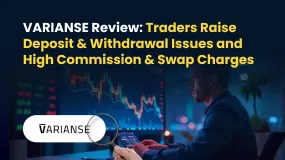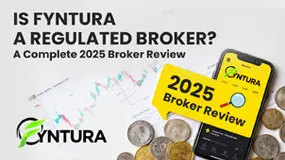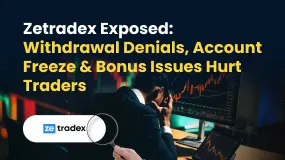简体中文
繁體中文
English
Pусский
日本語
ภาษาไทย
Tiếng Việt
Bahasa Indonesia
Español
हिन्दी
Filippiiniläinen
Français
Deutsch
Português
Türkçe
한국어
العربية
WIKIFX REPORT: The U.S. Dollar in the Market Today
Abstract:The term "U.S. dollar" refers to a specific denomination and the U.S. currency in general. It was initially traded as a coin worth its weight in silver or gold. Today, the dollar is one of the strongest currencies in the world. It’s officially in use in the United States and has been adopted by other countries. Somewhere between ½ and ⅔ of the circulated U.S. currency is outside the U.S.
The term “U.S. dollar” refers to a specific denomination and the U.S. currency in general. It was initially traded as a coin worth its weight in silver or gold. Today, the dollar is one of the strongest currencies in the world. Its officially in use in the United States and has been adopted by other countries. Somewhere between ½ and ⅔ of the circulated U.S. currency is outside the U.S.
A question here is how did the U.S. dollar make its way to the top?
The United States dollar is one of the most widely utilized currencies around the globe, both as an official currency and for international trade outside US. The currency as we know it today doesn‘t show up until the 20th century, but money in America has a much longer history. Read more to find out where the dollar came from and how it dominated the world’s markets.
Early Documentation of US Paper Bills – 1960
The oldest records of U.S. paper currency go back to the 1690s when the Massachusetts Bay Colony issued colonial notes to finance military expeditions. Other colonies soon followed and produced their own bills of credit.
Continental Currency – 1775
In 1775, the American Revolutionary War became inevitable. The Continental Congress issued a new form of paper currency, Continentals, to fund the military expenditures.
The Continental currency encountered several issues. One of them is that a large amount of money was being printed without bullion backing. This, and the emergence of counterfeits, would lead to the currencys massive devaluing. Congress stopped producing Continentals in 1779, and by the time the war ended, they were considered near worthless.
Adopting the Dollar Sign – 1785
The United States officially adopts the dollar sign in 1785. The symbol evolves from the Spanish American figure for pesos. Although Continental was denominated in dollars, it lacked the familiar dollar sign we know today. Simultaneously, Congress decided that the money would be based on a decimal system – 100 cents to a dollar.
The Bank of the United States – 1791
U.S. coins are produced by the United States Mint. U.S. dollar banknotes are printed by the Bureau of Engraving and Printing, and, since 1914, have been issued by the Federal Reserve. After the Revolutionary War, the U.S. was in financial chaos. By 1785, Continentals had depreciated so much that people no longer accepted them as payment.
Alexander Hamilton proposed a national bank to stabilise the economy and establish financial order. In 1791, the Bank of the United States was founded in Philadelphia.
Coinage Act of 1792
The 1792 Coinage Act formed the U.S. coinage system and the first U.S. Mint. The act laid the foundation for the nations future monetary system.
The currency circulated as only coins for decades, but the need for financing growth brought about the return of paper currency.
The Return of Dollar Bills
By the 19th century, the U.S. decided to give paper notes another go. In the 1860s, new bills were printed out to help finance the Civil War. These notes were green on the back; thus, they were called “greenbacks”.
The inking, treasury seals, and engraved signatures were meant to prevent counterfeiting.
Even though greenbacks had government backing, they couldnt be redeemed for gold or silver. However, the Specie Payment Resumption Act of 1875 restored the gold standard and ensured that all paper money could be exchanged for gold by 1879.
The Federal Reserve Act – 1913
The 1913 Federal Reserve Act led to the establishment of the Federal Reserve System as the nations central bank. It gave the Federal Reserve the ability to print money and oversee monetary policy in an attempt to establish and ensure economic stability.
The U.S. Dollar as the Reserve Currency
Instead of gold reserves, other countries accumulated reserves of U.S. dollars. 9 Needing a place to store their dollars, countries began buying U.S. Treasury securities, which they considered to be a safe store of money.
Back In the 20th century, war had left Europe in disarray and made way for the United States to emerge as the dominant economic power. In 1944, the Bretton Woods Agreement was formed, and the U.S. dollar became the worlds reserve currency.
However, the U.S. continued to print more money that exceeded the backing of gold reserves. Since paper dollars continued to flood markets, foreign countries became cautious and started to convert dollar reserves into gold.
Abandoning the Gold Standard
Following several runs on the dollar, in 1971, President Nixon enacted a set of economic policies. The Bretton Woods system wasnt formally abolished; however, the U.S. abandoned the gold standard and no longer converted dollars to gold at a fixed value. This led to the current system of fiat currency and floating exchange rates.
The U.S. Dollar in the Market Today
According to the history, governments, large companies, and hedge funds were the only ones engaging in foreign exchange with the dollar. But today, any interested individual can trade currencies.
Disclaimer:
The views in this article only represent the author's personal views, and do not constitute investment advice on this platform. This platform does not guarantee the accuracy, completeness and timeliness of the information in the article, and will not be liable for any loss caused by the use of or reliance on the information in the article.
Read more

WikiEXPO Dubai “Welcome Party” Concludes Successfully, Setting the Stage for the Main Event!
On the evening of November 10, 2025, the highly anticipated WikiEXPO Dubai “Welcome Party” was successfully held at the 6th Floor, Conrad Dubai, UAE. Serving as a “prelude” to the official opening of the expo, this event provided a high-end yet relaxed communication platform for representatives of global regulatory bodies, leaders of Fintech companies, renowned brokers, and senior executives of investment institutions.

VARIANSE Review: Traders Raise Deposit & Withdrawal Issues and High Commission & Swap Charges
Are you losing both while depositing and withdrawing your capital at VARIANSE? Does the broker give the currency conversion rate excuse for this? Have you been trapped with spreads charged higher than promised? Do you bear steep commission and swap charges at this broker? Traders frequently report these trading issues online. In today’s VARIANSE broker review, we have shared some trading complaints that have grabbed everyone’s attention. Take a look.

Is Fyntura a Regulated Broker? A Complete 2025 Broker Review
Fyntura is a broker accused by many users of posting fake reviews and running paid promotions with influencers to attract unsuspecting traders. Several users have faced withdrawal issues, blocked accounts, and manipulated trades. These are the real complaints and experiences shared by traders online. In this latest Fyntura Review 2025, you’ll learn about genuine user feedback, reported issues, and the broker’s credibility helping you make a better trading decision.

Zetradex Exposed: Withdrawal Denials, Account Freeze & Bonus Issues Hurt Traders
Do you constantly face withdrawal denials by Zetradex? Does the forex broker keep freezing your account and wiping out your capital? Have you also undergone issues concerning the Zetradex no deposit bonus? These trading issues have become apparent as the forex broker allegedly scams traders all over. In this Zetradex review article, we have demonstrated some complaints. Read them to get a feel of what happens to traders here.
WikiFX Broker
Latest News
BASF CEO: EU CO₂ Trading Is A "Destruction Mechanism" For European Industry
Is Fyntura a Regulated Broker? A Complete 2025 Broker Review
PINAKINE Broker India Review 2025: A Complete Guide to Safety and Services
Is Inzo Broker Safe or a Scam? An Evidence-Based Analysis for Traders
Is Uniglobe Markets Legit? A 2025 Simple Guide to Its Safety, Services, and User Warnings
Is Forex Zone Trading Regulated and Licensed?
WikiEXPO Dubai 2025 “Welcome Party” Kicks Off Tonight!
He Trusted a WhatsApp Group and Lost RM659,000
Exness Restricted Countries List 2025 Explained
Zetradex Exposed: Withdrawal Denials, Account Freeze & Bonus Issues Hurt Traders
Currency Calculator



